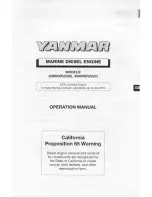
4
LOCKED FOR PRINTING – SELECT SECT. NEEDED >
83
Fig. 30
15
17
18
16
13. Remove screw (25) and choke plate (24),
Fig. 31
.
CAUTION
•
Carburetor body has a detent ball (19) and
spring (20) that keeps tension on choke shaft.
Wear eye protection.
•
Use caution when removing shaft!
AVOID EYE INJURY!
14. Remove E-ring (23), washer (22) choke shaft
and seal (21).
Fig. 31
ÔÔÔ
ÔÔÔ
Ó
Ó
19 20
21
22
23
23
21
22
24
25
15. Use a punch (26) to remove transitional hole
welch plug (27) from top of carburetor,
Fig. 32
.
Fig. 32
ÔÔ
ÔÔ
ÔÔ
ÎÎÎÎ
ÔÔÔ
ÔÔÔ
ÔÔÔ
26
27
This completes the carburetor disassembly
procedure.
Clean Carburetor
1. Disassemble carburetor.
2. Remove and discard all old gaskets, seals and
sealing material.
AVOID INJURY!
•
Wear suitable protection when using cleaners.
Follow instructions on container.
CAUTION
3. Use commercial carburetor cleaning solvents
(such as Briggs & Stratton Spray Cleaner, Part
#100041
or
#100042
) to clean carburetor parts
and body.
4. When cleaning non-metallic parts (plastic, ny-
lon, Minlon
, etc.), do not leave in commercial
carburetor cleaner more than 15 minutes.
NOTE:
Parts containing rubber, such as seals,
O-rings, inlet needles, seats or pump
diaphragms should never be placed in
commercial carburetor cleaner.
CAUTION
•
Wear eye protection whenever using com-
pressed air to clean parts.
AVOID EYE INJURY!
5. Use only compressed air (blowing in both
directions) to clean out all openings and
passages.
Содержание OHV V-Twin
Страница 27: ...1 26...
Страница 113: ...4 112...
Страница 156: ...10 155 Section 10 Crankshafts and Camshafts Page INSPECT CAMSHAFT 156 INSPECT CRANKSHAFT 156 INSPECT FLYWHEEL 157...
Страница 159: ...10 158...
Страница 177: ...12 176...
















































